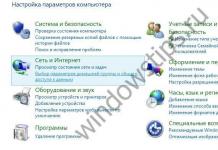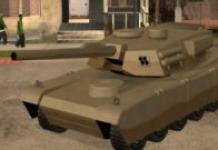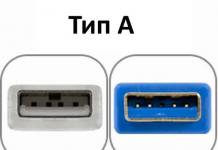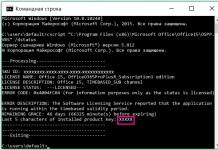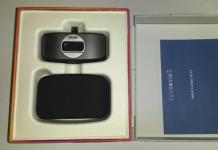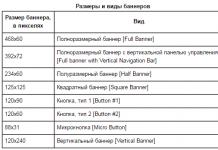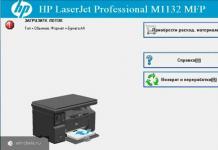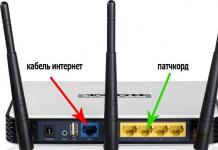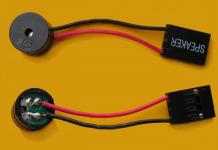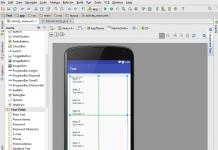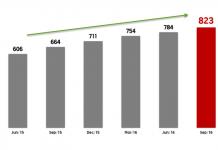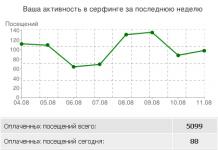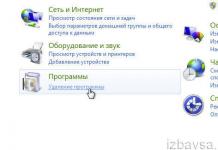Old age is when your children give you their old phone. © somewhere from the Internet.
In addition to the telephone, there may be a computer, TV, etc.
But in reality, this is not a solution at all, and so I started looking for the best computer for my parents.
A little background (you can skip it)
Immediately after school, I left my father’s house and still live on the other side of the country.
As a result, we rarely see each other and communicate mostly by phone.
The younger brother, who lives with his parents, got his own computer and connected to the Internet.
And then we began to use the capabilities of modern technologies - communicate via Skype, send photos and videos.
But by the age of 30, the youngest was still ready to live separately, and took his computer with him.
In order to restore communication, it was customary to take my wife’s old computer from the balcony, which she used before receiving the laptop, sweep away the dust from it and resuscitate it.
The very slow Windows was demolished and XP was installed on the fastest of the 2 screws (both 60 gigs), the operating speed was rated as quite satisfactory - enough for parents.
The system unit really made noise like a fighter jet, which was very annoying - so I cleaned it, removed half of the coolers in the case, and lubricated the remaining ones and replaced the bearings with the best ones that I removed. The noise level decreased and was also accepted by me as satisfactory.
Satisfied with myself, I sent the computer and waited for the result - but to my regret, none of my relatives with technical knowledge were able to install Skype into the system and configure everything so that the computer would be of use. To my proposals to watch a new video with their grandson on YouTube, I heard the answer “I’ll watch it at work.” I decided that my relatives simply had their hands in the wrong place, and decided to set everything up myself - fortunately it was summer and we were planning to visit my parents.
Once there, I spent half a day trying to fix something and realized that it was useless - the latest versions of Skype did not want to be installed, because they considered the processor architecture to be outdated, I of course found an archive of Skype versions and selected older ones that worked, but there were problems There are problems with the camera, then with the sound, or with something else. In the end, I realized that I just gave my parents rubbish, and it was better to buy something sensible.
I set out to find the optimal solution - sufficient in power for all basic tasks and at the same time not putting too much of a strain on the family budget.
I immediately rejected the idea of choosing among other old system units - a hefty box that hums like a vacuum cleaner, and at the same time consumes power that is completely out of proportion to the standards of modern technology.
Transformable tablets, which can be used as laptops, recently gaining popularity among the Chinese, were also not suitable - parents’ vision is no longer what it was in their youth, and forcing them to stare at a small screen is not humane. I immediately remembered that in addition to TV boxes on Android, the Chinese also began to produce the same ones on Windows. I was once thinking about buying something like this to use at home as a server for our small apartment network, especially since the cost of some 100-130 dollars seemed interesting to me. But I was not satisfied with the hdmi output - and my parents still had a normal LCD monitor with only a vga cord. Here on Muska I came across interesting reviews of copies with vga, but their price tag was significantly higher than what I expected. In the meantime, I was studying adapters with hdmi.
Directly to selection
Recently, my wife sent me a wish list from taobao.com, and I remembered an idea that had been floating around for a long time. On Taobao, at the request of minipc, I received quite a lot of offers.
I made myself a table of the main proposals, for clarity I wrote down the main parameters of interest.
Within the range of 400-550 yuan (rate 6.6 yuan/$) I had either fairly compact devices based on Z8300 and z3735 atoms but with soldered-in 2Gb memory and 32Gb flash, i.e. without the possibility of any upgrade or options with slightly larger dimensions, on celerons 1037U, J1900 and the like, but with empty slots for memory and ssd in msata format.
The same hardware based on Z8300 atoms, but with 4 gigabytes of RAM and 64 gigabytes of space, started at 700 yuan. In general, after rustling around the message boards a little, I saw that 4 gigs of DD3 sodimm can be bought from 10 bucks, and msata ssd 64 gigs - from 20 bucks. So an item was added to the selection criteria - the possibility of upgrading the memory/disk. But at the last moment I somehow accidentally came across an option, which I ended up buying - it attracted me not only because for the same 400-odd yuan I bought a computer with a 2GB memory stick already added, and a 24gb ssd (which it can also be replaced), the presence of a PS/2 output also had a significant effect - in addition to the monitor, the parents also had a very good keyboard and mouse with ps/2 plugs. Traces of use on the case did not bother me - I noticed that the Chinese often equip their devices with either brand new no-name components or branded used ones, and I somehow trust the latter more.
Order
There was relatively little information on the seller's page - only information about the amount of memory and size of the ssd and a couple of photos. Remembering that I pay by PayPal and if anything happens I will return the money, I decided to take a risk and order this option.
The total with delivery in China was 432 yuan ($65).
Upon arrival, the intermediary weighed the parcel - it turned out to be 1170 grams including the power supply and packaging. The intermediary conscientiously took photographs from all sides, showing every scratch. I noticed on one of the screws a seal dated exactly the date of purchase - this gave me hope that the seller had actually checked everything, so he put a warranty seal on it.
Since everything was sent together with other purchases, I calculated the cost of delivery to Ukraine based on the weight of the total - it turned out to be about 100 yuan, or $15. Those. In general, the device cost about $80.
I’ll probably skip the tracking and unpacking process and move on to the main thing.
Characteristics
Processor Intel Aton D2550 1.866Ghz 2 cores, 4 threads (although the description states Celeron 1037U)
- Intel NM10 chipset
- memory - 2Gb DDR3-1333, but works at 1066, maximum possible 4gb, one slot
- built-in SSD Sandisk i100 24Gb msata
- external ports: 4*USB 2.0, LAN 1Gb, VGA, HDMI, universal PS/2, sound
- ports available on the motherboard - 2*USB 2.0, SATA2, LPT, COM, lvds, miniPCI-E/msata
- included power supply 19v/2.1A
- dimensions - 19*19*3.5cm
- weight 700g, 1kg including power supply
Appearance and disassembly
I don’t know in what form my order arrived on Wednesday, but I received the computer itself only in an antistatic bag, and the power supply with the cord was wrapped in foam rubber. It was as if the power supply was more valuable.

But everything arrived intact. The cord with a plug is of unknown origin, but for the time of setup it was saved by a regular adapter, and in the future it can be easily replaced with a normal three-pin cord from a laptop power supply.

A little closer is the power supply that was included.

In the seller's photo it seems that the case is made of aluminum or other metal, but in reality it is ordinary plastic.
There is nothing special to look at on the case, except perhaps the rear output panel:

From left to right: universal ps/2 connector for keyboard and mouse (which actually attracted attention), microphone, speakers, USB 2.0 4 pieces with a gigabit LAN port, the VGA port itself, hdmi and power.
I immediately started looking for a splitter for the PS/2 port, but I barely found one - there were practically none left, they were only for USB, and I didn’t want to use them in vain.
On the front side there is only a power button, I decided not to photograph it.
To be more informative, even before turning it on for the first time, I decided to immediately climb inside. To do this you need to unscrew this cover.

By the way, the warranty seal that I tore off is dated 12/16 - just when I made the order.

In general, we remove the cover and see the motherboard and all its contents.

The most important thing that interested me was the number of memory slots, there is only one of them. There is no extra free miniPci-E, so wifi here can only be used externally via USB (which is what I actually did at the time of setup), but my parents have a cord for the computer, so they don’t even need it. There are a lot of pins on the board that I couldn’t identify at first, but later I found almost everything - there is a pin for a SATA2 screw (on the cover itself there is a place for mounting a 2.5" hard drive), a couple of free USB 2.0 outputs that you can use if you wish. display on the front panel, a couple of com ports, an LPT port, a lvds port for those who decide to use not a separate monitor, but connect directly to the matrix. There is also a PCI slot, but there is no point in it in this case.
Having unscrewed the motherboard and looked from the other side, I saw a lot of decoding of the connectors (this actually partially allowed me to decipher many of them), and also saw information about when this unit was probably purchased for the first time - about 4 years ago.

My native computer, on which I sit and from which I write, is significantly older.
Time has taken its toll on some details, such as traces of rust on the power-on LED contacts.

And judging by the adhesive tape that acts as electrical tape, the cooler was replaced.

Power-up and tests
So, the first turn on... and silence. More precisely, not silence - the power went on, and the cooling made it known, and the noise from the cooler is louder than from my system unit. But the connected monitor shows no signs.
A couple more attempts to turn it on and off - and nothing new.
I decided to follow the old scheme - I found a PC speaker and found where it belongs on the motherboard:

By the way, judging by the backlight of the cooler, it was probably removed from some kind of video card. In the same case, the backlight is completely useless, since it essentially only shines on the components on the motherboard. Perhaps it’s easier for them to work this way. :)
In general, the first test with the speaker - no new sounds. I start filming what I can film. First - memory, turn on - oh! yelled... It's already good! I return the memory to its place, turn it on - it continues to scream the same way. I re-plug it again, turn it on - and finally the long-awaited short “peak!” Perhaps when I took it apart for the first time, I inserted the memory poorly. I quickly connect the monitor with the keyboard and go into the BIOS:

In another tab I find information about the processor:

So, instead of the promised Celeron 1037U we have an Atom D2550.
What does it mean? Well, if you look superficially, the frequency is almost the same, and both are two-nuclear. But the Chinese won’t just fool around like that, so of course the promised 1037U has advantages over the atom - it’s just newer, and it already has a third-level cache, and supports two memory channels (i.e. on the motherboard it could well be 2 slots), and in general in many tests it bypasses the culprit of the review well. The only thing you can please yourself with is that the atom supports hypertrading (for me, a layman, this doesn’t mean much at all), and perhaps the only advantage is TPD, the atom has 10 versus 17 for the celeron. This also saves energy, and the cooler needs to work less to cool the processor. This means less noise - which was an important point in my selection criteria.
If anyone under the review adds some professional comment to this, it will definitely be useful to me when choosing a minicomputer for personal purposes - “a miniserver at home.”
In general, after tormenting Google, and realizing what exactly I got, I turned on the system to boot.

Windows, of course, is Chinese, broken - I found an activator on the desktop. :)
And I know that the monitor is dirty, I’ll definitely wipe it!
I loaded up and immediately went to check the rest of the points from the product description. The SSD actually turned out to be around the promised volume.
And for some reason, the Chinese split the already small disk into two logical partitions.

Windows is 32-bit, which is understandable in principle - with 2 gigs of RAM there is no point in setting it to 64.

It was also very interesting to find out what kind of motherboard is in this miracle, otherwise I couldn’t find any markings...

When I searched for TD2550G-x, Google gave me links only to Chinese sites like Ali, where this motherboard was offered for a fantastic $185. I didn't find anything else useful. But in the product description there was a picture that helped me decipher some of the outputs on the board:

Having dealt with the internals, I decided to solve the usability issue. Therefore, I started looking for how to change the language to Russian. I had to navigate stupidly using the pictures.

With the help of Google on a nearby computer, I finally found how to change the language by downloading the appropriate lang pack.

The next issue for me was operating comfort, namely the noise from the cooler, which was louder than my large system unit. And the first thing I did was download the SpeedFan software.
Having launched the program, I discovered a complete absence of any indicators of cooler speed, which means that no data from the tachometer is received by the motherboard. I had already decided that I would have to look for another cooler, but when I poked at the rotation speed percentage, it really quieted down - that suited me quite well. At maximum speed, the processor temperature remained around 50 degrees. With the permissible 100 degrees in the characteristics, there is enough reserve. I set the parameters to 60 degrees as a norm and 80 as a maximum, turned on automatic control and left it for a while. As a result, the temperature settled around 60 degrees, while the rotation speed was about 50%, it’s really so quiet that if you don’t put your ear close to the device, you won’t even guess that there is active cooling.

I decided to test the system to find out how the cooling copes and how the noise increases during loads.
The first thing that came to my mind was to start archiving - the processor was loaded somewhere around 80-90%, in 3 minutes the temperature rose to 65 degrees, but I didn’t even notice a difference in the cooling noise.

Then I decided to use a professional tool as well, and conducted a Stress Test with the AIDA program - I ran it for almost 10 minutes and it didn’t work out to heat up in any noticeable way, the cooling also behaved well.

Now to the real tasks. FullHD video with a bitrate of 60 megabits - the processor does not even strain, it is loaded somewhere on average by 15%. The video runs without a single lag, although at first I had to strain myself with the choice of player.

I had to tinker with the browser. I wanted to find one that would consume a minimum of resources. I went through 6-7 different ones that were recommended for weak computers.
All of them performed very poorly - somewhere the site showed you a mobile version (for example, the same ok.ru, which is just important for parents), somewhere there were other lags, in none of them the video from YouTube played normally.
In the end, I demolished everything and installed the regular version of Firefox - it performed better than some specialized builds, and there were no problems at all on YouTube. Videos were played without problems up to FullHD resolution.
I thought about getting 4 gigs of memory before, but now I see that 2 is enough.
I was also thinking about buying a 2.5 HDD for it, since 200 gigs can easily be bought for 100-150 hryvnia (up to 5 bucks), but I saw that after installing all the necessary programs (office 2003, skype, browser, video player, avast) on There are still 11 gigs left on the C drive, parents won’t download movies and music - they’re already used to being online. Without delay, I collected everything and sent it.
As a result, the children now ask to call their grandparents almost every evening, and mom has already shown dad all our family videos on YouTube, which previously she could only watch at work.
conclusions
Despite some of the Chinese's tricks, my parents and I were completely satisfied with the purchase. Mom is still trying to find out how much this computer cost, otherwise the size and complete glitch-free nature of their requests - she thinks that it cost a lot of money.
I plan to order one for myself, too, but I decided to make a choice based on the comments to this review.
Hi all.
This is my first review of gadgets on this site. Why did you decide to buy a Chinese mini PC?
I am engaged in video production. I work in Edius, Photoshop, Adobe After Effect.
Configuration of my old computer:
Intel Core Duo E7500 2.93Ghz
Video card built-in
4 GB memory
2 sata screws.
The performance of my PC is quite enough for normal work. There is only one drawback of my computer - it is VERY NOISE. Lately, this has started to bother me a lot, so I started looking for an alternative.
There weren't many alternatives and not all of them met my criteria.
First option.
Computer from the manufacturer Apple. I tried several times to master programs on this operating system, but it didn’t work.
Second option.
Buy a laptop or netbook. I simply can’t stand this form factor.
Third option.
Intel NUC, the price, in my opinion, is a little overpriced.
These were the options I had. All of them did not quite suit my small needs.
Since 2010, I have been constantly buying goods for myself and my family via the Internet. Most of all comes from the Chinese site While shopping on the AliExpress website, I came across interesting Chinese Mini PCs (Chinese analogue of Intel NUC) in aluminum cases. The most important thing for me about these PCs was that they did not create noise!!!
We began searching for reviews on the Internet, but, unfortunately, there were very few of them at that time. I found only two in Russian, and they weren’t exactly informative, so to speak :(
Since I have not been interested in the latest achievements in the computer industry for a very long time, it was difficult for me to determine what the Celeron, iCore 3, i5, i7, etc. system is today. meets my requirements, and my requirements were very simple, the main thing is that the computer should not work slower than the old one.
I had to spend a lot of time searching for the information I needed, but I never found it.
Then I decided to focus on price. I set the price level to 250 dollars. The PC had to have 4 GB of RAM, 32 GB SSD screw. With the rest of the money, it was necessary to find a processor with a motherboard.
There were several options: Celeron 1037U, Core i5200u, Pen j2850 and others, but I chose the Core i3 4010U (4015) processor.
Several days were spent searching for the best seller with prices for the goods. After corresponding with several applicants on the AliExpress website, I chose this one http://ali.pub/1uv9l.
Due to changes in customs rules in our country (Ukraine), the limit on one parcel without filing a declaration is 150 euros, a small problem arose regarding the registration of the parcel. The problem was solved very simply, the seller wrote the cost of the mini PC a little less :) than it actually was. They can write you any price you want.
I asked for 4 GB of Samsung memory and the Win7 operating system. The seller sent the parcel via EMC courier service. Delivery was already included in the price of the Mini PC. The track number on the official website was tracked only on the third day. After 12-13 days, the track appeared on the EMC website of the city of Kharkov.
Thank you for reading this far, now let’s move on to the review of the mini PC.
I missed a few details in the text, so in addition you can watch the review on the YouTube channel.
The parcel contained:
White packaging box.
Aluminium case.
Computer stand.
HDMI cable
Power supply with Euro plug.
Wi-Fi antennas
Let's start with the body.
It is made of thick cast aluminum with holes on the sides and top. The case thickness is 29mm. Dimensions 197*197*29mm. Very neat and beautiful. Weighs about 1.2 kg.
Now let's go through the connectors.
2 USB 2.0 connectors
4 USB 3.0 connectors
Video outputs: HDMI, VGA
Ethernet port 1 Gbit
Audio input and output
Connectors for Wi-Fi antennas 150 Mbit (for an additional $3 the seller will make 300 Mbit)
On/off button.
Now let's look at the filling.
Motherboard with Core i3 4010U processor
RAM DDR3L 4 GB Samsung and SSD 32 GB hard drive.
Built-in video card.
Wi-Fi module
On the case cover there are holes for another SSD screw and for a special VESA mount. Using this mount, the PC can be attached to the back cover of the monitor or to the wall.
If you ask the seller to install bluetooth 4.0, he will do it for you for free. Unfortunately, I didn’t know this and therefore I had to buy USB bluetooth for $3 to connect a mini keyboard.
After the first boot of the system, there was not as much free space as I expected. With Win7 installed by Chinese friends, there was 11.3 GB of free space. Having installed all the programs for work, there was only about 2GB left, which is very, very little. Therefore, I decided to order another ssd screw.
For people who want to buy such a PC just for the Internet and watching movies on-line, I think 11 GB is enough for normal work.
At the moment, I'm very happy with everything. It performs all the tasks that I need.
Such mini computers will find their buyer. I think this is a compromise between a desktop PC and a laptop. They will be in demand both in enterprises and for people who do not need large, powerful and noisy personal computers. One of these is Ya.
For myself, I haven’t found any disadvantages in this PC yet.
The advantages are SILENCE and tranquility (I work at night, when my family is already asleep). A small bonus is low energy consumption.
I filmed the opening of the parcel in the video below.
If you have questions or find technical inaccuracies in my review, please write them, I will try to answer them and correct errors. Click on LIKE and comment on my first post.
It's been a long time since computers took up an entire desk. Today, powerful mini PCs are the size of a sandwich. Whether you're looking for a compact device to free up space in your apartment or want to create an entertainment media center for yourself while traveling, you'll find the right option in this selection.
We present to our readers the February 2017 top five best mini pcs. We invite you to read the review and choose the device to your liking.
Mini PC on Windows Azulle A-1063-AAP Access Plus Stick
With Cherry Trail T3 Z8300 processor (2GB + 32GB)
Access Plus belongs to the new line of mini computer consoles from Azulle. Unlike previous mini-PC models presented by Azulle, the Access Plus clearly stands out. The device has many applications for various services such as Netflix, Skype and Windows applications. A direct internet connection is also available - these are just a few of the features that Access Plus has to offer.
The device is compact, so it fits easily into your pocket. Thanks to this, the gadget can be used not only while traveling, but also go online and view content absolutely anywhere where you can connect to a monitor or TV.
The Portable Access Plus is a cooler-free mini PC that lets you do the same things as a regular PC without any problems.
Personally, I use the device as a media center with Kodi player. At first, I was a little doubtful whether this thing could cope with the entire list of capabilities that were attributed to it? Have you seen the first Chromecasts? This is what I expected.
As it turned out, my doubts were in vain. Let's start with the fact that the build quality is at the highest level. The device has a metal body, very moderate weight and impeccable quality. This is a very fast mini PC that easily replaces a regular one if the user needs Internet access, access to email or office applications.
With 2GB RAM and 32GB ROM, not counting 64GB - the maximum expandable memory - the user will have more than enough space to store their files. To summarize, this model is a good option that will certainly brighten up your leisure time:
- Activated Windows 10 OS,
- high speed,
- stable work.
The device does not heat up during resource-intensive operations, high build quality, 4 USB connectors... We are delighted with this model!
mini PC GOLE1
With Intel Z8300 processor and Windows 10 / Android 5.1(4 GB + 64 GB)
The GOLE1 is equipped with a quad-core processor and an Intel Gen 8-LP video accelerator. In addition, there is a touch screen, thanks to which the device can be used anywhere, regardless of the speed of the Internet connection via Wi-Fi. And the dimensions of the gadget (135 x 90 x 20 mm) allow you to carry it with you in a small suitcase, backpack or pocket.
Great mini computer. This model was purchased to replace a bulky laptop on which presentations were created using the OpenLP program, which works great on GOLE1.
The screen is clear and crisp, and Windows 10 works as it should. High-speed SD cards are not supported, but class 4 cards work fine. Personally, I use a 32GB class 4 card without any problems, and I also watch high-definition videos without any lag.
I work on the device using the Rii i8 92 Mouse Touchpad Combo wireless keyboard or simply connect a wireless mouse. Both devices are perfectly recognized. HDMI, HDMI and VGA connectors work without problems, and the sound quality transmitted through headphones connected to the HDMI connector is commendable.
I really liked the Gole1 and am very glad I purchased this model.
mini PC Byte Plus
With Intel CherryTrail T3 Quad-Core Z8300 (4GB + 32GB)

Byte Plus is part of the new line of mini-PCs from Azulle. The device is designed to perform many different multitasking operations. Azulle has equipped the Byte Plus with a 64-bit quad-core Intel Atom Cherry Trail processor.
Byte Plus via HDMI or VGA connectors. Services such as Netflix, YouTube and Amazon Prime are available on the device. And with the help of Microsoft Office you can complete tasks for work or school. It doesn’t matter what the nature of the tasks is - Byte Plus can handle any!
An excellent mini PC not only for everyday work, but also as a media center. I must say, very cheap.
This is a very compact and stylish device, with solid build quality. In addition, the gadget does not make a sound during operation. I would have shelled out for a more powerful version of this model, but even this small and remote computer provides enough features to satisfy the needs of most users.
It is worth noting that you can install Linux like Ubuntu 15 and higher on a mini PC. And since the device supports 32-bit systems, the latter will be the best option.
After fiddling around with other systems, I came to the conclusion that it works best on Ubuntu. Others had difficulty installing.
If you are happy with Windows, then there will be no problems at all.
Where to buy cheap?
This review is subjective and emotional. I did not pursue the goal of comparing this device with similar ones, I just wanted to study the details that interested me.
I've been looking at mini-computers from a small Chinese company, Eglobal Technology Co., for a long time. Their feature is passive cooling and low price. They have many different options, even on Core i7. But before the advent of solutions based on Broadwell processors, I didn’t want to take on an HTPC for myself.
This review will focus on a mini-computer with an Intel Core i3-5005U processor. This is the youngest Core i3 processor of the Broadwell family with low power consumption. A friend ordered this computer on advice, I just took it for testing.
Impression
This is a very cool mini computer with an ideal cooling system. It is a pleasure to work with it, complete silence. For my main work, I use a desktop computer with a top-end Core i7 and am very picky about performance. During the entire time I was testing the mini-computer, I did not feel any discomfort in the speed of operation - instant response to any actions without hesitation or pauses, everything was very fast. I was disappointed that Broadwell-U processors, at least with an Intel Graphics HD 5500 controller, were not ready for the 4K HEVC era. You will read about this in the review.
General view and equipment
At the time of writing the review, a barebone (without RAM and disk) with a Core i3-5005U processor could be purchased, for example, on Aliexpress for $230, including express delivery to Russia. For an additional $15, you can get the Core i3-5010U option, which features a larger chassis, two Gigabit Ethernet ports, and two HDMI ports.
The computer comes in a small and simple box.
Inside: the computer itself, a vertical stand, a power supply (forgot to place it in the frame), a power cable, an HDMI cable, two antennas.

The computer can be mounted horizontally, vertically on a stand, or behind the monitor using a VESA mount, which is sold separately.

Computer dimensions: 20x20x3.5 cm. Weight: 1.5 kg. The body is made of aluminum. The thickness of the case walls is 2.5 mm. The upper wall is made with ribs, its thickness is about 13 mm. This wall is the basis for heat removal, because the processor is adjacent to it on the opposite side.

At the front end there is a power button with an indicator. On the side there are 2 USB 2.0 ports and 2 SMA connectors for antennas. At the rear end: analog audio output, analog microphone input, 4 USB 3.0 ports, Gigabit Ethernet port, VGA output, HDMI output, 12V power connector.



The computer is equipped with a power supply with a current of 3A.
There are 8 screws on the bottom cover. 4 for attaching the cover, 4 for attaching the 2.5-inch disk.

The computer is very easy to disassemble. Unscrew the 4 screws and simply remove the cover. There is a small circuit board inside.
The board contains:
- mSATA port for SSD installation
- Mini PCIe port for installing a Wi-Fi adapter
- 2 slots for SO-DIMM DDR3L memory
- 2 SATA ports
- 2 power connectors for drives

The Gigabit Ethernet controller is based on the Realtek RTL8168 chip. Wi-Fi controller - Broadcom BCM43224AG, supports 2.4 GHz and 5 GHz bands, MIMO 2x2. The sound controller for analog interfaces is implemented on Realtek ALC662. The processor is located on the back side of the board and is adjacent to the case. The chipset is integrated on the processor substrate.
For testing, two 4 GB DDR3 PC3-12800 memory sticks were added to the computer. The total amount of RAM is 8 GB. A simple 2.5-inch Kingmax 60 GB SSD drive (of course, it is optimal to install an mSATA SSD drive and use the disk space for a regular HDD). Windows 8.1 Professional was installed on the computer in 7 minutes.
A small note about UEFI/BIOS. The computer uses UEFI from AMI with a fully unlocked menu, i.e. Absolutely everything possible is available. The Chinese comrades did not complicate their lives by disabling certain menus, but left everything as it was in the engineering version.
Cooling
The most important question that bothered me was how does passive cooling cope with heat dissipation? This is still not Atom. Similar mini-computers, including NUC from Intel on Broadwell, have an active cooling system.
The computer is based on an Intel Core i3-5005U processor with Broadwell architecture. Contains 2 physical cores with support for Hyper-threading technology - 4 threads. The maximum processor frequency is 2 GHz. The processor has a built-in graphics controller Intel HD Graphics 5500 with 24 execution units, maximum frequency - 850 MHz. 
Many laptops and mini-computers, even with an active cooling system, are subject to throttling under maximum load. When a certain temperature of the cores is reached, clock cycles are skipped, the operating frequency is reduced and the cores are turned off.
The first test that will be used is Intel Linpack in the LinX graphics wrapper. This stress test is one of the hottest and can easily turn the processor into a frying pan. It is often used to test the stability of overclocked processors. Temperature measurements were carried out using the AIDA64 and HWiNFO programs.
Room temperature about 25 ºC. Core temperature without load is about 45 ºC. Linpack is allocated 6 GB of RAM. In 15 minutes the temperature did not rise above 69 ºC. For a passive cooling system, this is simply an amazing result! No throttling. The computer case was hot, about 50 ºC on the top cover, which is absolutely normal for a passive system. 
The next test is less intensive for the processor, but involves the graphics controller - the AIDA64 stress test. Within 10 minutes of the test, the temperature stabilized at 70 ºC and did not increase. And again, no problems with cooling, everything is just perfect. 
We'll come back to heating when we look at the 3DMark test, but we can safely say that this is a mini-computer with an ideal passive cooling system.
Performance
As I already wrote, subjectively the system works very quickly. There is no discomfort, microfreezes, lags, or slowdowns. I will not focus on the performance test, but I will provide several results so that you can compare them yourself with other data on the iXBT website if necessary.
Test Geekbench. Single-core - 2197, Multi-core - 4589. 
Test Cinebench R15. CPU - 211. GPU - 28 fps. 
RAM speed test.

Test 3DMark. Ice Storm Extreme - 31487, Cloud Gate - 4432. During the test, the temperature of the GPU and processor cores did not even exceed 60 ºC.


Testing the speed of network interfaces
As I already wrote, the Gigabit Ethernet controller is based on the Realtek RTL8168 chip. Wi-Fi controller - Broadcom BCM43224AG, supports 2.4 GHz and 5 GHz bands, MIMO 2x2.
The speed of the wired interface is quite standard. The actual speed of copying files from the NAS and to the NAS, which was the work computer, is about 110 MB/s or 880 Mbit/s.

My mini-computer was located very far from the base station; I did not test Wi-Fi in detail. When connected at 5 GHz, the copy speed from the NAS was about 9 MB/s (or 72 Mbps). At the same time, a work laptop in the same place produced 5 MB/s, and a smartphone 3.5 MB/s. Quite a good result.
Playing video
This is the second most important question that bothered me. Intel has announced hardware (hybrid) acceleration of HEVC and HEVC 10-bit video playback (Main 10) in Broadwell processors, starting with the HD 5500 controller. This is what we will check.
The computer supports UHD 3840x2160 24Hz resolution via HDMI. I connected an LG TV to check. The presence of this support is a very big plus for using a mini-computer as an HTPC. But I did all the tests with a monitor at a resolution of 2560x1440 60 Hz.
Let's see what the VPU in Broadwell with HD 5500 generally supports.

As you can see, a full bouquet, including 4K HEVC and 4K HEVC Main10. We will test the decoding speed using DXVA Checker.
To complete the picture, I will include H.264 video in the tests, although this has not been a problem for a long time. Standard Ducks Take Off, which are used in iXBT tests. 1080p 109 Mbps and 2160p 243 Mbps. There is no surprise here, everything is very fast.

All available (there are not very many of them) 1080p movies and TV series encoded in H.265/HEVC can be played without problems, both with hardware acceleration and software. Even a modern Atom can handle them. We will not dwell on them. We will test HEVC decoding only on complex content and content of the near future - UHD resolution (4K), high bitrate, 8 and 10 bits.
Files for testing 8 bits:
2160p playback 
Internet Explorer plays smoothly, CPU load is about 10%. Firefox plays smoothly, CPU usage is about 40%. Chrome, due to the fact that the VP9 software decoder is used, cannot cope, frames are dropped, it is impossible to watch normally, the load is about 90%. For Chrome, the Core i3-5005U processor is not enough power.
1080p60 playback

Internet Explorer plays smoothly, CPU load is about 7%. Firefox plays smoothly, CPU usage is about 22%. Chrome plays smoothly, CPU usage is about 60%.
Conclusion
This mini-computer is worthy of a place on your desk or near your TV. There were no problems or difficulties during the test. Perfect stability. Complete silence thanks to the passive cooling system. Considering the budget price, this is a very good choice for a wide range of tasks. Just know that this computer will not step into the 4K HEVC era.
Once upon a time, nettops were predicted only for office life, and this was true, but recently the home user has become interested in this category of devices. And the point is not at all in the popularity of the home office concept, but in the simplicity and convenience of mini-computers for everything at once. Of course, there are no gaming nettops a priori, but you can no longer call them typewriters hidden behind a monitor. At the current time, such devices are in no way inferior to even the most productive ultrabooks, significantly saving desktop space and sometimes even outperforming bulky all-in-one PCs. Today's review will be devoted to the TOP 5 best mini PCs of 2017 from leading manufacturers.
Mini PC Acer Revo M2-601
A neat square box with dimensions of 135x135x56 mm and a weight of 1.2 kg is designed to be “inconspicuous” on the table. However, it will provide you not only with working with documents, but also with multimedia entertainment. This guy looks so nice that he evokes the effect of “I want, I want, I want” even with a cursory examination, but he must have pitfalls.
- Appearance. Acer didn’t come up with anything new in terms of design; it simply refined the “square” form factor by implementing an orange border around the perimeter and slightly smoothing the corners of the matte plastic body. At the same time, even the power button looks harmonious, because this is not just a nettop, but a modular computer. Its functionality can be expanded indefinitely, and it itself will eventually grow to the size of a small system unit. It is precisely to ensure that it does not look heterogeneous that such a universal and laconic design was chosen. However, no one bothers you to use only the main module, which you can put in your backpack and go in search of a donor monitor.
- Iron. The whole thing runs under the full-fledged Windows 10 Home and a mobile dual-core Core i3 6100U processor with a clock frequency of up to 2300 MHz and a 3-MB L3 cache. 4 GB of DDR4 memory are responsible for performance, and the hard drive is as much as one terabyte for data storage. This is what the dimensions and weight of the device are equal to. The picture is completed by the Intel HD Graphics 520 video core, capable of not only casual games, but also modern quests with all that that entails. The bottom line is that you get a compact multimedia center that can be upgraded if desired.
- Ports and communications. The set of interfaces also indicates that it belongs to the latter. So on board this baby: DisplayPort, HDMI and three full USB 3.0. The first two are used to connect a monitor or monitors, the remaining ports can be used for peripherals, such as a mouse, printer and flash drive. Of the wireless interfaces - Wi-Fi of all standards and the fourth Bluetooth. There is also a gigabit LAN, as without it. The price tag is also quite reasonable, since for this price it’s unlikely to buy a decent Intel laptop, but here it’s both a laptop and a desktop at the same time.
Mini PC ASUS VivoMini VC65

ASUS went even further and rolled out a nettop to the market with unprecedented performance, the hardware of which can be upgraded. True, the modular system here is highly specialized: it is only possible to increase the internal memory of the device, although, if desired, the RAM strips also change.
- Appearance. Externally, the device is far from the “cheerful” design of the Acer Revo M2-601 - strict straight lines of the metal case, gray color, black insert hiding ventilation holes and an optional optical drive. Everything says about who the device is addressed to. The set of interfaces is rich and will also suit the corporate user. Dimensions: 197.5x196.3x49.3–61.9 mm. The last indicator depends on whether you need to work with DVD-RW or not. This serious fellow weighs 2.2 kg and is designed to take root on the office desktop. It will not be possible to add another module on top - this is a self-sufficient device.
- Iron. The sixth generation Intel Core i5-6400T or i3-6100T may be hidden in the depths of a small square box, depending on the model. The clock frequency of the first chip can reach 2.8 GHz; the chipset is Intel H170, a top-end video adapter Intel HD Graphics 530 with claims for games of the 15th year. Agree, this is a good configuration for a nettop, fortunately there are 16 GB of DDR3L-1600 memory on board, this is only the case with the older model. The basic one assumes 4 GB of RAM in SO-DIMM format. However, the most interesting thing lies in the possible internal storage options. So, you can choose a model with a 2.5-inch 250 GB or terabyte HDD, 32 or 128 GB SSD, one 32/128 GB solid state drive and a 512 or 1024 GB hard drive, as well as four drives with 3 TB together. Thus, this is enough to implement a small working server; fortunately, the disks can be combined into a RAID array and the gadget can be used as a NAS. In addition to this, you get 100 GB of ASUS Webstorage proprietary cloud with a free annual subscription. We don’t know why the developer is positioning his brainchild strictly for the corporate segment, since such a nettop wouldn’t hurt at all at home. At the same time, it can serve as an autonomous multimedia center for all household members. This miracle comes with pre-installed Windows 10 Home, Windows 10 Pro and Windows 7 Professional with the option of free up to professional “tens”.
- Interface set corresponding: 4-in-1 card reader, HDMI and VGA output, gigabit LAN, COM port for business peripherals, Kensington Lock, two headphone and microphone jacks, and four USB 3.1 Gen 1. Not every business The laptop can boast of this; in short, there will be no problems connecting external devices. At the same time, an active cooling system is implemented based on a cooler, a tube and a copper base, which is barely audible even under maximum loads.
- Wireless interfaces Wi-Fi 802.11 ac/Bluetooth 4.0 or Wi-Fi 802.11 b/g/n/Bluetooth 4.0 are presented, there is a special application for streaming video to TVs and smartphones. In short, it’s a complete mess for the price of a full-fledged laptop, although it’s much more versatile than the latter.
HP Elite Slice G1 Mini PC

And this is another modular device that can be expanded with an optical drive, an audio console and a VESA mount. The hardware also didn’t let us down, so this comrade can safely be called the golden mean, receiving the compact body of the Acer Revo M2-601 and the performance of the ASUS VivoMini VC65.
- Appearance. To be honest, the developers of the HP Elite Slice G1 took inspiration from the Apple Mac Mini. Almost the same dimensions: 35x165x165 mm, and weight 943 grams, and the same sloping sides, however, this concept is characteristic of the entire Elite line, and the corrugated “copper” edging of the metal case is completely unique. Moreover, this is not just a edging, but a kind of cooling system located around the perimeter of the device. The bottom is slightly sloping for a reason - this is a lock for other modules, which, unlike the Acer Revo M2-601, are placed not on top, but on the bottom of the gadget, and the device itself crowns the top. It must be admitted that heat removal in this case is much more efficient than that of a competitor, which operates on both blowing and blowing. In addition, a fingerprint sensor is optionally available, located on the right side of the body directly on the radiator grille. If you don’t know about it, then finding a fingerprint sensor is extremely difficult, which only adds to security.
- Iron. Another difference from the Apple Mac Mini is an external power supply and pre-installed Windows 10 in two top editions. The entire line of Intel processors with the “T” prefix can be responsible for performance - the sixth generation Intel Core i3, i5 and i7, and this is a frequency of up to 3.5 GHz and a hot thermal package of 35 W, hence a more thoughtful CO. Otherwise: 520 graphics, up to 8 GB of RAM in fast DDR4 format and up to 512 GB SSD drive. If we look at independent tests, the device outperforms its competitor by 25%. It turns out that what we have in front of us is far from a typewriter, but even a hint of this year’s online games, coupled with the ability to turn the TV into a powerful multimedia center.
- Interfaces. The set of ports is the most necessary. It includes: two traditional USB 3.0 ports, two USB-C, HDMI, DisplayPort, Ethernet and a Kensington lock slot. It turns out that, if desired, you can connect up to three monitors and use them for work and entertainment at the same time. As in the case of the Acer Revo M2-601, all interfaces are located on the back, and not on the front, like the practical ASUS VivoMini VC65. However, for such compact dimensions this is not critical, but what a presentable appearance it is, which is equally good for the office and home environment. True, the nettop heats up noticeably, especially when working with two monitors or trying to run DOTA on medium settings. The price tag, yes, bites, but this is the case when we overpay for the brand.
Mini PC MSI Cubi 2

MSI doesn't have enough stars in the sky, offering a classic nettop for simple tasks. If it weren’t for the beveled edge of the case on the left with the original power button, the device would generally be impossible to distinguish from an army of inexpensive Chinese devices and even set-top boxes. But the price tag is more than acceptable, but there are other tricks up its sleeve.
- About appearance Almost everything has already been said. It remains to add that the dimensions of the device are 115.2x112.2x32.6 mm. Moreover, the height of the case can be 42.7 mm, and the weight can vary from 390 to 510 grams. Yes, you understood correctly - this baby is also modular, but in addition you can connect an SSD or HDD drive of your choice. Moreover, it can be a pair of an M2 drive and a hard drive, or a solid-state drive and a regular HDD. A VESA mount is placed on top of the whole thing, but we wouldn’t risk attaching such a pie to a “liquid” 22-inch monitor. In addition, some of the vital interfaces are located on the frontal plane, which will cause some inconvenience with the installation method described above.
- Iron. I'm glad that this inexpensive nettop uses the seventh generation of Intel processors, in particular the U-line. These are quite energy-efficient solutions for a wide range of tasks with low heat generation and frequencies up to 3.1 GHz. No one is stopping you from increasing the RAM to 32 GB, but 16 GB is enough, fortunately it is in DDR4-2133 format. At the same time, you can also order almost any size of solid-state or HDD drive and increase the storage capacity to one and a half terabytes. MSI has always been famous for adequate pre-orders, so it is not at all necessary to be content with models available only in your city. It will cost a little more, though, but still.
- From interfaces- USB 3.1 Gen 1 and USB 3.1 Gen1 Type-C on the front panel, that is, you can connect both a mobile device and connect an external hard drive, for example, download movies from a friend. Next to the high-speed ports there is a separate microphone output and a separate 3.5 mm jack. On the rear panel there is a full HDMI, DP output, LAN port and two USB 3.1 first generation, as well as a socket for the power supply. Wireless - dual-band Wi-Fi in AC standard and Bluetooth 4.1. The cooling system is active with a fan that has a double-row ball bearing. It turns on only at maximum load, but produces a characteristic noise that can be called pleasant to the ears, but does not require maintenance, and the blades are made in such a way that they collect a minimum of dust. For this price, MSI Cubi 2 is one of the best options for work and entertainment within the walls of your own home.
HP Pavilion Wave 600 Mini PC

Before us, of course, is not a clone of the Mac Pro, but a MacPro-like device, although inside there is a completely different song and the device is designed to live more at home than in the office. Thus, we have another NAS station for multimedia entertainment, presented in four different models. As you may have guessed, modular design is out of the question.
- Appearance. No, this is not a white cylinder with a turbine-fan at the very top, but its style is still blurred by the “apple”; even the triangular form factor, textured finish and hot air diffuser cup on top cannot help. In short, you might not immediately guess that this is a Hewlett-Packard, since the device is very different from the semicircular style of the Pavilion. At the same time, it cannot be called a large stele - dimensions: 168x173x230 mm with a weight of almost 2 kg. In this case, the location of the device ports is interesting. Most of them are hidden in a recess on the back of the device, including the power button, which is quite difficult to find blindly. In front there is only USB 3.0, and a combined audio jack. This thing looks unusual, but from an ergonomic point of view it’s not all convenient, since at first you’ll definitely have to twist the trihedron to connect peripherals.
- Iron. The device comes only with pre-installed 64-bit Windows 10 Home 64 and carries on board an Intel Core i3-7100T (3.4 GHz, 3 MB cache, 2 cores) or an Intel Core i5-7400T (clock speed up to 3 GHz, 6 MB cache memory, 4 cores), which is very good for a nettop, but this is not quite a nettop. The fact is that there is discrete graphics here, expressed in the Radeon R9 M470 video card with 2 GB of GDDR5 memory, which is complemented by the Intel HD Graphics 630 video core. Thus, you can not limit yourself to watching 4K video, but also play some games games even this year. True, you shouldn’t count on AAA franchises. Internal storage can be represented by a terabyte or 2 terabyte disk with a spindle speed of 7200 rpm, which is not bad at all, although a small SSD or M2 disk for the operating system would not go amiss.
- Interface set for such a size it could have been richer. Available: USB 3.0 Type-C, three USB 3.0, DisplayPort and HDMI for connecting a monitor, there is a card reader, and Wi-Fi ac and Bluetooth 4.2 are used for wireless connection. There was also a gigabit LAN. The reason for the paucity of ports lies again in the design, since it is actually much more difficult to place iron in a trihedron than in a cylinder. The cooling system is also interesting, where cold air is taken not from the bottom, but from the front of the case, and hot air is exhausted to the top. It would be naive to think that such an unusual device from mercantile HP would be cheap.
So that's what we have. In fact, all five nettops in this review deserve attention, which, you see, is rare. At the same time, the five will definitely find its buyer, since now the mini-computer is not a faceless box modestly hiding behind the monitor, turning it into a typewriter, but a completely serious device not only for multimedia, but also for games. Thanks to the productive mobile hardware for this. Don’t forget that now nettops are modular, which means they are in no way inferior to regular desktops and show their language to ultrabooks.
Thus, the Acer Revo M2-601 and MSI Cubi 2 can be called devices for everyone, since they can be used to create an ideal configuration for both home and office, emptying your pocket within reasonable limits. ASUS VivoMini VC65 is for maximalists in terms of technology, since we have a set-top box and a NAS, as well as a work and home computer at the same time, but in this case you should not count on price concessions. The HP Elite Slice G1 and HP Pavilion Wave 600 will suit the aesthetes more, as appearance is at stake here, and performance is intelligently combined with efficient cooling. True, in the first case you get a miniature modular device, in the second something resembling a wireless speaker without the possibility of an upgrade (not for enthusiasts), but with the ability to choose your ideal ready-made model.


